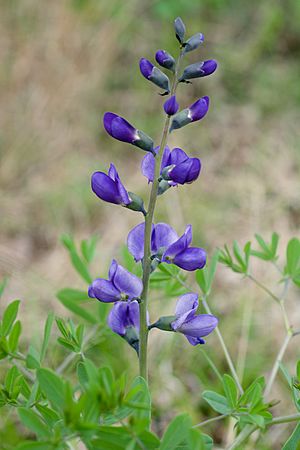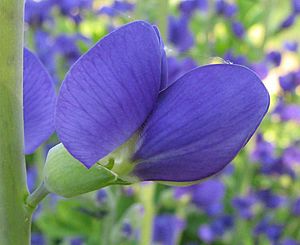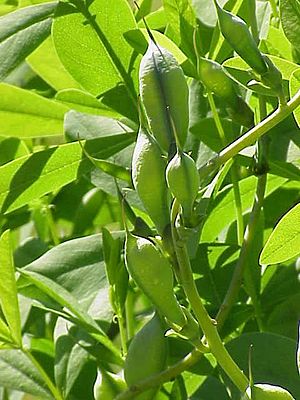Blue wild indigo facts for kids
Quick facts for kids Blue wild indigo |
|
|---|---|
 |
|
| Conservation status | |
| Scientific classification | |
| Kingdom: | |
| (unranked): | |
| (unranked): | |
| (unranked): | |
| Order: | |
| Family: | |
| Genus: |
Baptisia
|
| Species: |
B. australis
|
| Binomial name | |
| Baptisia australis |
|
| Synonyms | |
|
|
Baptisia australis, often called blue wild indigo or blue false indigo, is a beautiful flowering plant. It belongs to the Fabaceae family, also known as the pea or legume family. This plant naturally grows across central and eastern North America. You can find it in wild places like forest edges, along streams, or in open fields. It can be hard for new plants to grow from seeds in its natural home. This is because tiny weevils often get into the seed pods. The plant is only slightly harmful to humans if eaten.
Contents
What's in a Name?
The name of the plant's group, Baptisia, comes from an Ancient Greek word. Bapto means "to dip" or "to immerse." The second part of its scientific name, australis, is Latin for "southern."
People also call this plant by other common names. These include indigo weed, rattleweed, rattlebush, and horsefly weed. The name "blue false indigo" comes from its use as a dye. It was used as a replacement for the better dye plant, Indigofera tinctoria.
Plant Description
B. australis is an herbaceous perennial plant. This means it has soft stems and lives for more than two years. It can grow new plants from seeds and also from its spreading underground stems called rhizomes. The plant grows upright from these rhizomes.
Roots and Stems
The roots of the plant are deep and branched. This helps it survive when there isn't much rain. If you dig them up, they look woody and black. They also have small bumps called tubercles. The plant branches out a lot about halfway up its stem. The stems are strong and smooth. If a stem breaks, a sap comes out that turns dark blue when it touches the air.
Size and Leaves
This plant can grow quite tall, reaching about 1 to 1.5 meters (3 to 5 feet) high. It can also spread out to be 0.6 to 1 meter (2 to 3 feet) wide. Its leaves are a grey-green color and grow in an alternating pattern. Each leaf has three smaller leaflets, like a clover. These leaflets are wider near their tips.
Flowers and Fruits
Flower spikes appear in early summer. They grow at the top of the plant in short, upright clusters. The flowers look like pea flowers and can be light blue to deep violet. They are about 2.5 cm (1 inch) long. These flowers bloom from spring to summer, depending on the area.
After the flowers, the plant grows bluish-black, puffed-up pods. These pods are hard and range from 2.5 to 7.5 cm (1 to 3 inches) long. They are oblong and have a sharp tip. Inside, they hold many loose, yellowish-brown, kidney-shaped seeds. These seeds are very small, about 2 mm (0.08 inches) in size.
The leaves grow about a month before the flowers appear. They fall off about a month after the pods form. Once the seeds are fully grown, the stems turn a silvery-grey color. They then break off from the roots. The pods stay attached to the stems and are blown to new places by the wind.

Is it Safe to Eat?
Young shoots of this plant have sometimes been mistaken for asparagus. Eating them can cause poisoning. The seeds may also be harmful, especially for children. It's best not to eat any part of this plant.
Plant Varieties
There are three types, or varieties, of B. australis that scientists recognize:
- Baptisia australis var. abberans
- Baptisia australis var. australis
- Baptisia australis var. minor
Growing Blue Wild Indigo
B. australis is the most popular plant in its group to grow in gardens. People grow it even outside of North America, like in Great Britain. There, it has won an award for being a great garden plant. Gardeners like it for its deep blue to violet flowers in spring. They also enjoy its pretty light green leaves and its unique oblong fruits that appear in late summer.
Best Growing Conditions
This plant grows best in soil that is well-drained and doesn't have much lime. It likes full sun or partial shade. It can grow to be about 90 to 120 cm (3 to 4 feet) tall and just as wide. Like other plants in its group, it has a very deep main root called a taproot. This makes it hard to move once it's planted.
It grows well in full sun and only needs water when there hasn't been much rain. One small thing to know is that its leaves tend to fall off early in the autumn. You can avoid this by cutting back the dead stems. This plant can survive cold winters in USDA zones 3 through 8. It is often used as a border plant in gardens.
Hybrids and Smaller Varieties
While there aren't many common types of B. australis you can buy, some new plants have been made by crossing it with other Baptisia plants. For example, 'Purple Smoke' is a mix of B. australis and Baptisia alba.
The variety B. australis var. minor is also sometimes grown in gardens. It is much shorter, only about 30 to 60 cm (1 to 2 feet) tall. However, its flowers are the same size as the taller varieties.
Other Uses of the Plant
Several American Indian tribes used this plant for different purposes. The Cherokee people traditionally used it to make a blue dye. European settlers later learned this practice from them.
The Cherokees also used the roots to make teas. These teas were used to help with stomach problems, toothaches, and nausea. The Osage people used the plant to make an eyewash. The ripened seed pods were sometimes used by children as rattles.



